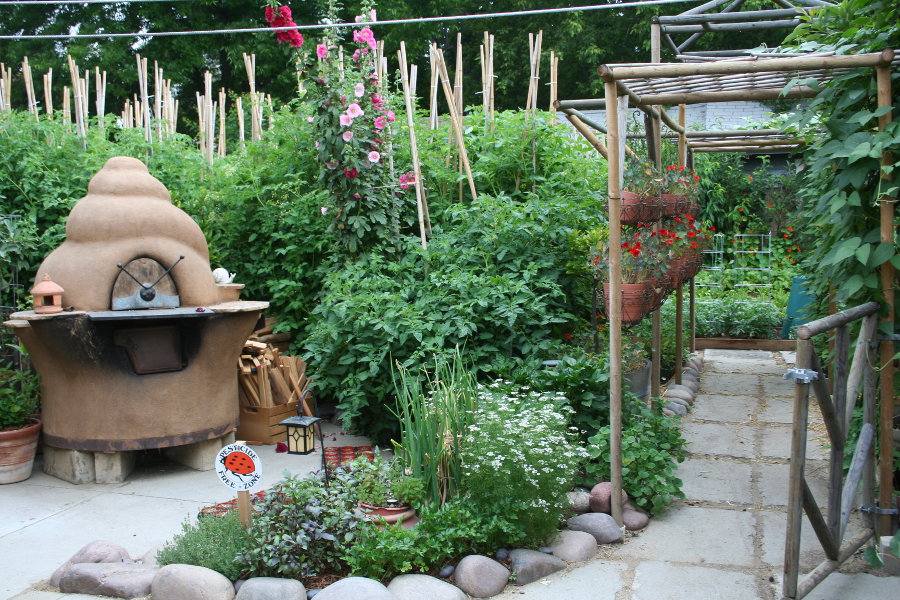March 17, 2012


The Dervaes Institute implemented the Urban Homestead ® program to help people living in urban environments become less reliant on purchasing food by growing their own. But, the Urban Homestead program is more than just growing plants. The program instructs residents how to restore a failing property, how to be better citizens, and how to be good neighbors who pitch in to help improve their community. (Photo courtesy of The Dervaes Institute)
[nggallery id=132 template=carousel images=12][imagebrowser id=132]
By Mike Brandolino
Until a couple of generations ago, many families were either completely self-sufficient or relied only on local producers for agricultural products. It was commonplace for families in rural and urban areas to grow, harvest, and process homegrown fruits and vegetables with little reliance on markets.
Today, the rising cost of raw materials and fuel is impacting the price of food at the supermarket. The sluggish economy is forcing many people to cut back on both basic and discretionary items.
The Dervaes Institute in Pasadena, CA has developed creative methods to become self-sufficient in a society where most people are compelled to purchase everything from big box retailers and massive supermarkets.
On a small plot of land, not far from a major highway, the Dervaes Institute has been reducing its dependence on this system.
Urban Homestead® Program
The institute implemented the Urban Homestead ® program to help people living in urban environments become less reliant on purchasing food by growing their own. But, the Urban Homestead program is more than just growing plants. The program instructs residents how to restore a failing property, how to be better citizens, and how to be good neighbors who pitch in to help improve their community.
Urban homesteading was developed about 40 years ago. The first US cities to implement the program were Wilmington, Delaware; Philadelphia, Pennsylvania; and Baltimore, Maryland. Each of these cities had severely economically depressed areas that needed revitalization.
Over the last several decades, the concept expanded across the country and the Dervaes Institute adopted the Urban Homesteading program. The institute created its own Urban Homestead ® program with these 10 guidelines:
1. Grow your own food on your city lot;
2. Use alternative energy;
3. Use alternative fuels and transportation;
4. Raise farm animals for manure and food;
5. Practice waste reduction;
6. Reclaim and reuse grey water and collect rainwater;
7. Live simply;
8. Do the work yourself;
9. Work at home; and
10. Be a good neighbor.
Obviously, it will be difficult for anyone to adopt these guidelines all at once. The easiest place to start is at Step 10 – Be a good neighbor. When you are a good neighbor, you have the potential to become a pillar in your community. Everyone can look to you for guidance to learn how to be responsible community residents. Being a good neighbor goes a long way in the community.
You can take steps to grow food on your city lot. If you have limited space, consider starting a container garden. There are minimal start-up costs and you have the benefit of easy access to fresh food.
Alternative energy sources, such as solar power, require initial start-up costs to install the technology. Eventually, the system will more than pay for itself.
Raising farm animals on your property may be subject to legal restrictions in your community. Check with the local authorities and municipalities for specific rules and restrictions.
Waste reduction goes beyond your local recycling program. Consider your spending habits. Do you purchase items that you will probably rarely or never use and only throw away? Do you buy excess food that is wasted and goes in the trash? Take some time to think about all of your purchases to save money and reduce your wasteful impacts casino online on the planet.
Some homeowners are installing grey water recovery and recycling systems in their homes. Grey water is water that is recovered from bathtub, sink, shower, and dishwasher drains. Grey water and rainwater is held in a storage tank, which is used to operate the toilets and even for irrigation. It is a cost-saving measure to use grey water for toilets rather than clean, fresh water.
Nearly everyone wants to take steps to simplify their lives to reduce stress, eat healthier, and live just a bit better. One of things that you can do is start processing and preserving the foods that you grow in your yard or container gardens. This can be a great opportunity to get the entire family involved in a weekend project. Turn off the television, video games, and cell phones. Setting aside some family time without unnecessary distractions can be a great stress reliever.
If you are handy around the home, you have already taken steps to saving your family money. If you are afraid or uncertain about making repairs, seek the advice of friend, relative, or neighbor. You can start with small simple repairs and then progress towards more complex tasks.
Many people have the luxury of the option to work at home. Obviously, not everyone has the ability to work from a remote location. However, if your onsite job has remote location flexibility, consider working from home to save on transportation costs.
Sierra Club Green Home recommends that our readers follow the lead of the Dervaes Institute and the Urban Homestead ® guidelines. Simplifying your life may take some initial work and a lot of practice, both mentally and physically. However, the benefits are worth the efforts.
© 2012 SCGH, LLC.
]]>